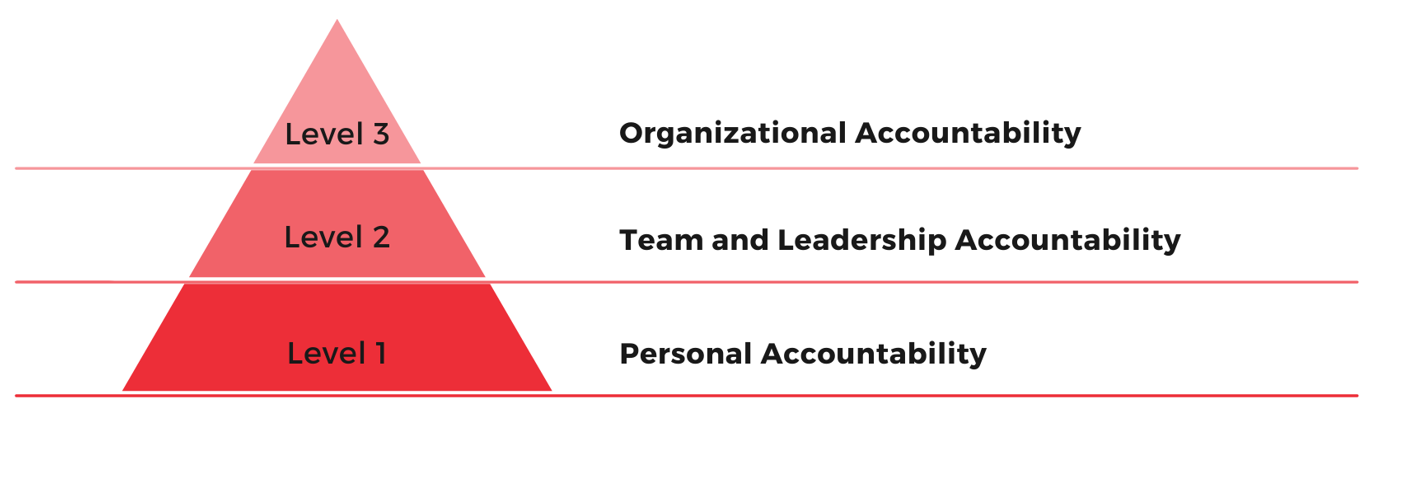The leaders we speak to often say one of the biggest challenges they face in their companies is accountability. As we noted in a recent post, some of the phrases that are heard in places with low accountability are:
- That isn’t my job.
- I wasn’t aware of the deadline.
- I didn’t get the (insert report, input, information) from (insert colleague’s name).
- I’ve kept every email, and you can see here in writing…
- No one told me.
- But I followed the process.
- That’s above my pay grade.
- I have no idea how that happened.
The Accountability Pyramid

Accountability is like a pyramid. The stability of each level is dependent on the levels below it. We can’t have team accountability if the individual members of the team are not accountable. And the organization will not have a Culture of Accountability throughout without both highly accountable teams AND individuals.
The Results 4Cs provides a playbook for team performance, so in this post let’s focus on personal accountability.
The Accountability Ladder
The Accountability Ladder is a tool for understanding how to climb out of our own reactive, victim mindsets. It helps us recognize that every time we make excuses, claim ignorance or point fingers at others, we are demonstrating victim behaviors.
As leaders it’s important to look at ourselves in the mirror first. What are times when we make excuses or blame other people when outcomes or performance are lacking? Ironically, even saying something like, “the problem in my organization is that my employees are not accountable enough,” is a form of blame. You can’t hold others to a standard of performance in any area unless you model the way yourself.
 As people move up the accountability ladder, we start to see changes in mindset, language, and behaviors. Instead of the below the line victims we start to see above the line elements. We see people taking notice when things are not going right or trending in the wrong direction and doing something about it (I SEE IT). Employees start to take ownership of results, not just following the steps and going through the motions (I OWN IT). They solve problems that arise (I SEEK SOLUTIONS) either individually or with others on the team. And finally they act (I MAKE IT HAPPEN) rather than waiting for something to happen.
As people move up the accountability ladder, we start to see changes in mindset, language, and behaviors. Instead of the below the line victims we start to see above the line elements. We see people taking notice when things are not going right or trending in the wrong direction and doing something about it (I SEE IT). Employees start to take ownership of results, not just following the steps and going through the motions (I OWN IT). They solve problems that arise (I SEEK SOLUTIONS) either individually or with others on the team. And finally they act (I MAKE IT HAPPEN) rather than waiting for something to happen. Nicholas Murray Butler is the former President of Columbia University. He divides people into three categories: “First, there are those who make things happen; second, those who watch things happening; and third, the vast majority who have no notion what is happening.” High accountability cultures are populated with people in his first category.
Climbing the Accountability Ladder
The first step in solving any problem is recognizing there is a problem. Leaders can start useful discussions by posing questions like, “what does accountability look like to you?” or “when do we see victim or blame behaviors and language?” The table below provides a contrast between the Cultures of Blame and Accountability. Share this and ask people what they see and hear in themselves and in the organization.

Another way to assess how your organization rates is to download our free Accountability Assessment. Share the assessment with three or more team members, then complete the assessment independently and then come together to discuss your results.

If you’d like to learn more about accountability or other ways you can take the simpler path to creating a great business, connect with us.
Article by Tim O’Connor



